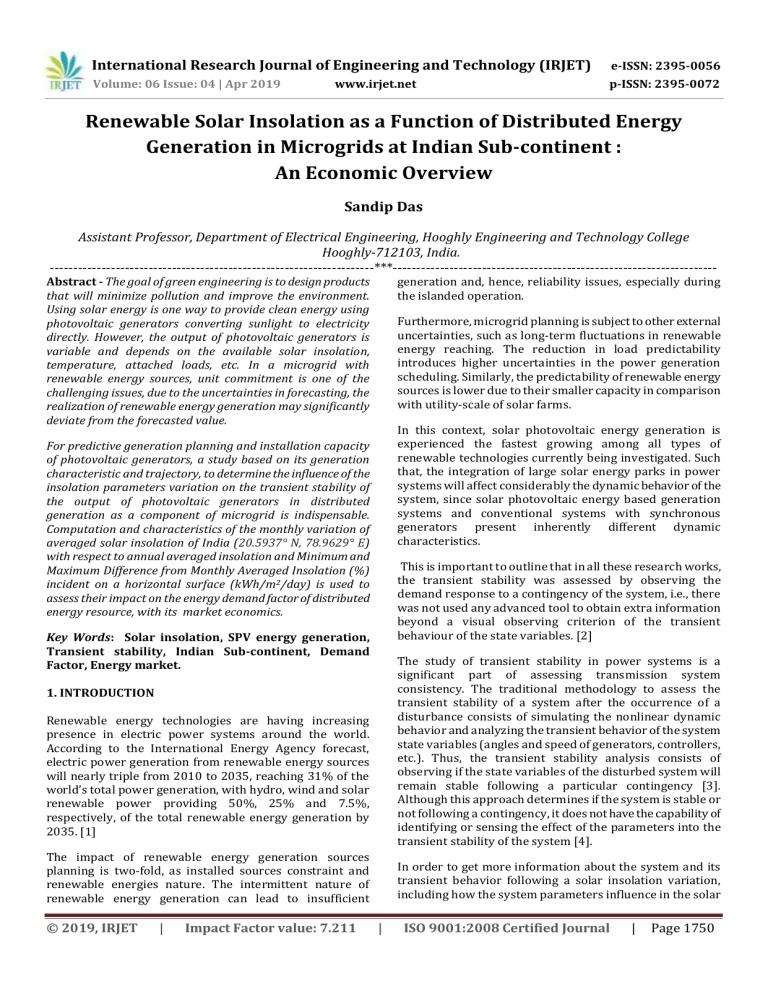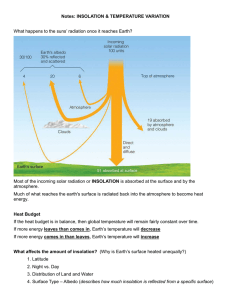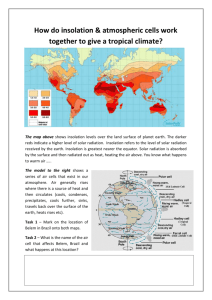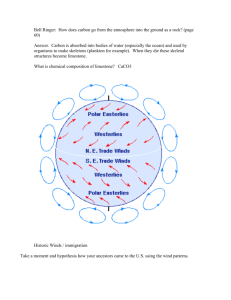Solar Insolation & Microgrids in India: Economic Overview

International Research Journal of Engineering and Technology (IRJET) e-ISSN: 2395-0056
Volume: 06 Issue: 04 | Apr 2019 www.irjet.net p-ISSN: 2395-0072
Renewable Solar Insolation as a Function of Distributed Energy
Generation in Microgrids at Indian Sub-continent :
An Economic Overview
Sandip Das
Assistant Professor, Department of Electrical Engineering, Hooghly Engineering and Technology College
Hooghly-712103, India.
---------------------------------------------------------------------***---------------------------------------------------------------------
Abstract The goal of green engineering is to design products that will minimize pollution and improve the environment.
Using solar energy is one way to provide clean energy using photovoltaic generators converting sunlight to electricity directly. However, the output of photovoltaic generators is variable and depends on the available solar insolation, temperature, attached loads, etc. In a microgrid with renewable energy sources, unit commitment is one of the challenging issues, due to the uncertainties in forecasting, the realization of renewable energy generation may significantly deviate from the forecasted value. generation and, hence, reliability issues, especially during the islanded operation.
Furthermore, microgrid planning is subject to other external uncertainties, such as long-term fluctuations in renewable energy reaching. The reduction in load predictability introduces higher uncertainties in the power generation scheduling. Similarly, the predictability of renewable energy sources is lower due to their smaller capacity in comparison with utility-scale of solar farms.
For predictive generation planning and installation capacity of photovoltaic generators, a study based on its generation characteristic and trajectory, to determine the influence of the insolation parameters variation on the transient stability of the output of photovoltaic generators in distributed generation as a component of microgrid is indispensable.
Computation and characteristics of the monthly variation of averaged solar insolation of India ( 20.5937° N, 78.9629° E ) with respect to annual averaged insolation and Minimum and
Maximum Difference from Monthly Averaged Insolation (%) incident on a horizontal surface (kWh/m 2 /day) is used to assess their impact on the energy demand factor of distributed energy resource, with its market economics.
In this context, solar photovoltaic energy generation is experienced the fastest growing among all types of renewable technologies currently being investigated. Such that, the integration of large solar energy parks in power systems will affect considerably the dynamic behavior of the system, since solar photovoltaic energy based generation systems and conventional systems with synchronous generators present inherently different dynamic characteristics.
This is important to outline that in all these research works, the transient stability was assessed by observing the demand response to a contingency of the system, i.e., there was not used any advanced tool to obtain extra information beyond a visual observing criterion of the transient behaviour of the state variables. [2] Key Words : Solar insolation, SPV energy generation,
Transient stability, Indian Sub-continent, Demand
Factor, Energy market.
1. INTRODUCTION
Renewable energy technologies are having increasing presence in electric power systems around the world.
According to the International Energy Agency forecast, electric power generation from renewable energy sources will nearly triple from 2010 to 2035, reaching 31% of the world’s total power generation, with hydro, wind and solar renewable power providing 50%, 25% and 7.5%, respectively, of the total renewable energy generation by
2035. [1]
The study of transient stability in power systems is a significant part of assessing transmission system consistency. The traditional methodology to assess the transient stability of a system after the occurrence of a disturbance consists of simulating the nonlinear dynamic behavior and analyzing the transient behavior of the system state variables (angles and speed of generators, controllers, etc.). Thus, the transient stability analysis consists of observing if the state variables of the disturbed system will remain stable following a particular contingency [3].
Although this approach determines if the system is stable or not following a contingency, it does not have the capability of identifying or sensing the effect of the parameters into the transient stability of the system [4].
The impact of renewable energy generation sources planning is two-fold, as installed sources constraint and renewable energies nature. The intermittent nature of renewable energy generation can lead to insufficient
In order to get more information about the system and its transient behavior following a solar insolation variation, including how the system parameters influence in the solar
© 2019, IRJET | Impact Factor value: 7.211 | ISO 9001:2008 Certified Journal | Page 1750
International Research Journal of Engineering and Technology (IRJET) e-ISSN: 2395-0056
Volume: 06 Issue: 04 | Apr 2019 www.irjet.net p-ISSN: 2395-0072 photovoltaic generator’s transient response, we propose to apply an effective methodology based on the sensitivity theory of dynamic systems [3]. The goal of proposing the application of the sensitivity theory to assess the solar photovoltaic generator’s dynamic behavior is to find out how sensitive is the twelve month averaged solar insolation variation state variables to annual averaged insolation and
Minimum & Maximum Difference from Monthly Averaged
Insolation (%) incident on a horizontal surface
(kWh/m 2 /day). Although, this is out of the scope of this paper, such invaluable information (trajectory sensitivities) could be used to improve the transient stability of solar photovoltaic energy generator’s, by modulating the most sensitive system parameters, that could extract maximum power from PV arrays with the help of maximum power point tracking (MPPT). [5]
2.2 Numerical calculation of trajectory sensitivities
The numerical computation of Trajectory Sensitivities (TS) requires only a nominal and a perturbed simulation in the time domain. This formulation is easier to implement than that of an analytical formulation. If it is considered a very small perturbation over the nominal parameter such that the sensitivities can also be calculated in a simpler way by assuming that the slope of the tangent line to the nominal trajectory solution at is well approximated by the slope of the secant line through and the perturbed trajectory solution.
3. INDIAN SUB-CONTINENTAL SCENARIO
The solar insolation data available from NASA surface meteorology and solar energy for Indian Sub-continental
Latitude 20.594 & Longitude 78.963 taken from the NASA
GEOS-4 model elevation is in table 1 and table 2.
2. TRAJECTORY SENSITIVITY THEORY FOR DIFFENTIAL
EQUATIONS SYSTEMS
Dynamic systems are usually described by a set of
Differential Equations. Here, the variable pattern of insolation is considered as V, a vector of dynamic state variables g, h, t; where g is the time varying matrix of twelve month averaged solar insolation variation, h is time varying matrix minimum & maximum difference from monthly averaged insolation (%) and t is time variation in twelve months.
Table -1: Solar insolation data of 1 st Half-yearly
Monthly Averaged Insolation Incident On A Horizontal
Surface (kWh/m 2 /day)
Lat
20.594
Lon
78.963
Jan Feb Mar Apr May Jun
So, the insolation vector is explicitly modeled by the set of differential equations through the function, as 22-year
Average
4.78 5.63 6.30 6.80 6.66 5.03
;
With initial conditions and is a set of time invariant parameters of the system as,
Table -2: Solar insolation data of 2 nd Half-yearly
Monthly Averaged Insolation Incident On A Horizontal
Surface (kWh/m 2 /day)
;
2.1 Analytical formulation of trajectory sensitivities
The sensitivities of dynamic state vector with respect to a chosen system’s parameter i.e. averaged solar insolation variation at a time along the trajectory are obtained from the partial derivative as,
Lat
20.594
Lon
78.963
Jul Aug Sep Oct Nov Dec
22-year
Average
4.07 3.91 4.72 5.16 4.87 4.61
Where, n is 12, for different twelve month averaged values.
The smooth evolution of the sensitivities along the trajectory is obtained by differentiating the values, where time varying matrices computed along the system trajectories. [4]
Where the annual averaged value is 5.20 kWh/m 2 /day. [5]
3.1 Nature of solar insolation throughout the year
The graphical representation of these insolation trajectories throughout the year with its average values shows a varying nature of characteristics. This would be helpful to predict its energy generation, as a futuristic view.
© 2019, IRJET | Impact Factor value: 7.211 | ISO 9001:2008 Certified Journal | Page 1751
International Research Journal of Engineering and Technology (IRJET) e-ISSN: 2395-0056
Volume: 06 Issue: 04 | Apr 2019 www.irjet.net p-ISSN: 2395-0072
Chart -1 : Monthly average and annual average in respect of time.
These predictive mode of energy conversions with microgrid made effects on energy market economics & its tariff structures, as Genco (Generating Company), Transco
(Transmission Company), Discom (Distribution Company),
Resco (Retail Energy Service Company), Market Operators
(MO), System Operators (SO), Transmission System Operator
(TSO), Independent System Operator (ISO) and customers works as different entity.
The characteristics insolation trajectories show, its have much higher value in one half of the year and in other half it’s a little bit lower from the average. Depending upon this the demand factor can be managed by using distributed energy sources and supplying from microgrid or making it islanding.
4. CONCLUSION
These distributed energy conversions made effects on energy market structures, as Genco (Generating Company),
Transco (Transmission Company), Discom (Distribution
Company), Resco (Retail Energy Service Company), Market
Operators (MO), System Operators (SO), Transmission
System Operator (TSO), Independent System Operator (ISO) and customers work as different entity. Proper prescheduled operation of microgrid at peak load of the conventional grid system, would drop down the energy cost, and would work for betterment of the society.
3.2 Compensating the demand at peak time minimizing energy cost
Demand Factor is always change with the time to time or hours to hours of use and it will not constant. The connected load is always known so it will be easy to calculate the maximum demand if the demand factor for a certain supply is known at different time intervals and seasons.
The demand of energy at peak load can be compensated with the surplus of SPV distributed generation, as per the predicted nature of generation characteristic, of a particular area and forecasted load. Thus scheduling of connecting of distributed resources forming the microgrid and islanding of the same may be designed. The trajectory of maximum & minimum generation based on insolation and their deviation from yearly average generation in Chart – 2 shows it properly.
Chart -2 : Maximum and minimum insolation difference from average in %, with respect of time.
ACKNOWLEDGEMENT
The author acknowledges that, "These data were obtained from the NASA Langley Research Center Atmospheric
Science Data Center Surface meteorological and Solar Energy
(SSE) web portal supported by the NASA LaRC POWER
Project."
REFERENCES
[1] International Energy Agency. World Energy Outlook,
2012; Paris, France, 2012.
[2] Hao Liang and Weihua Zhuang, Stochastic Modeling
and Optimization in a Microgrid: A Survey; Energies
2014.
[3] P. W. Sauer and M. A. Pai, Power System Dynamics and
Stability. Upper Saddle River, New Jersey 07458:
Prentice-Hall, 1998.
[4] I. A. Hiskens and M. A. Pai, “Trajectory sensitivity analysis of hybrid systems,” Transactions on Circuits and
Systems, vol. 47, pp. 204-220, February 2000.
[5] Sandip Das, A model based solar insolation utiliser for socio economic development, Computer,
Communication, Control and Information Technology
(C3IT), 2015, Third International Conference on Year:
2015.
[6] P. Kundur, Power System Stability and Control. New
York: McGraw-Hill, 1994
© 2019, IRJET | Impact Factor value: 7.211 | ISO 9001:2008 Certified Journal | Page 1752
International Research Journal of Engineering and Technology (IRJET) e-ISSN: 2395-0056
Volume: 06 Issue: 04 | Apr 2019 www.irjet.net p-ISSN: 2395-0072
BIOGRAPHIES
Sandip Das has done his M.E. from
Electrical Engineering Department of
Jadavpur University, Kolkata (W.B.), and India. Now he is working as
Assistant Professor in the
Department of Electrical Engineering,
H.E.T.C., affiliated to Maulana Abul
Kalam Azad University of Technology.
His core area of interest is Renewable
& Non-conventional Energy,
Energy Management and
Electrical Energy Generation,
Control & Distribution.
© 2019, IRJET | Impact Factor value: 7.211 | ISO 9001:2008 Certified Journal | Page 1753



